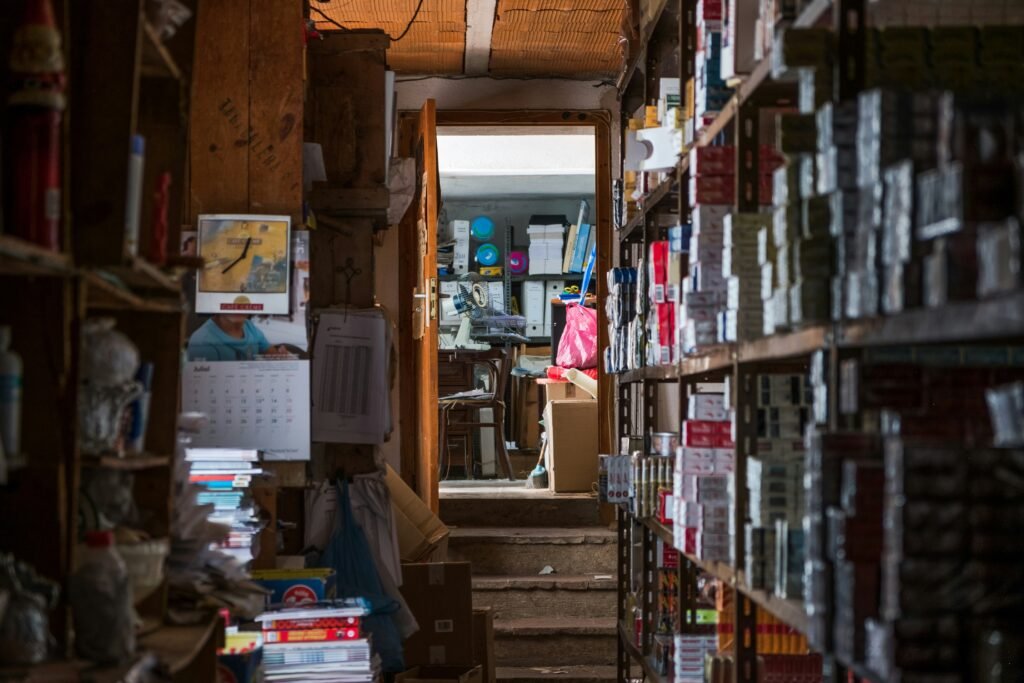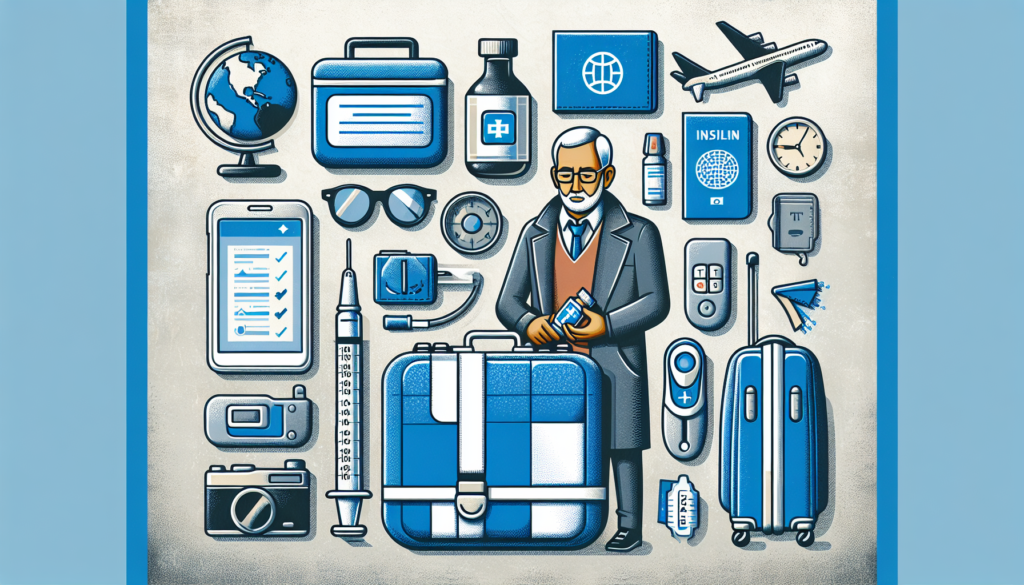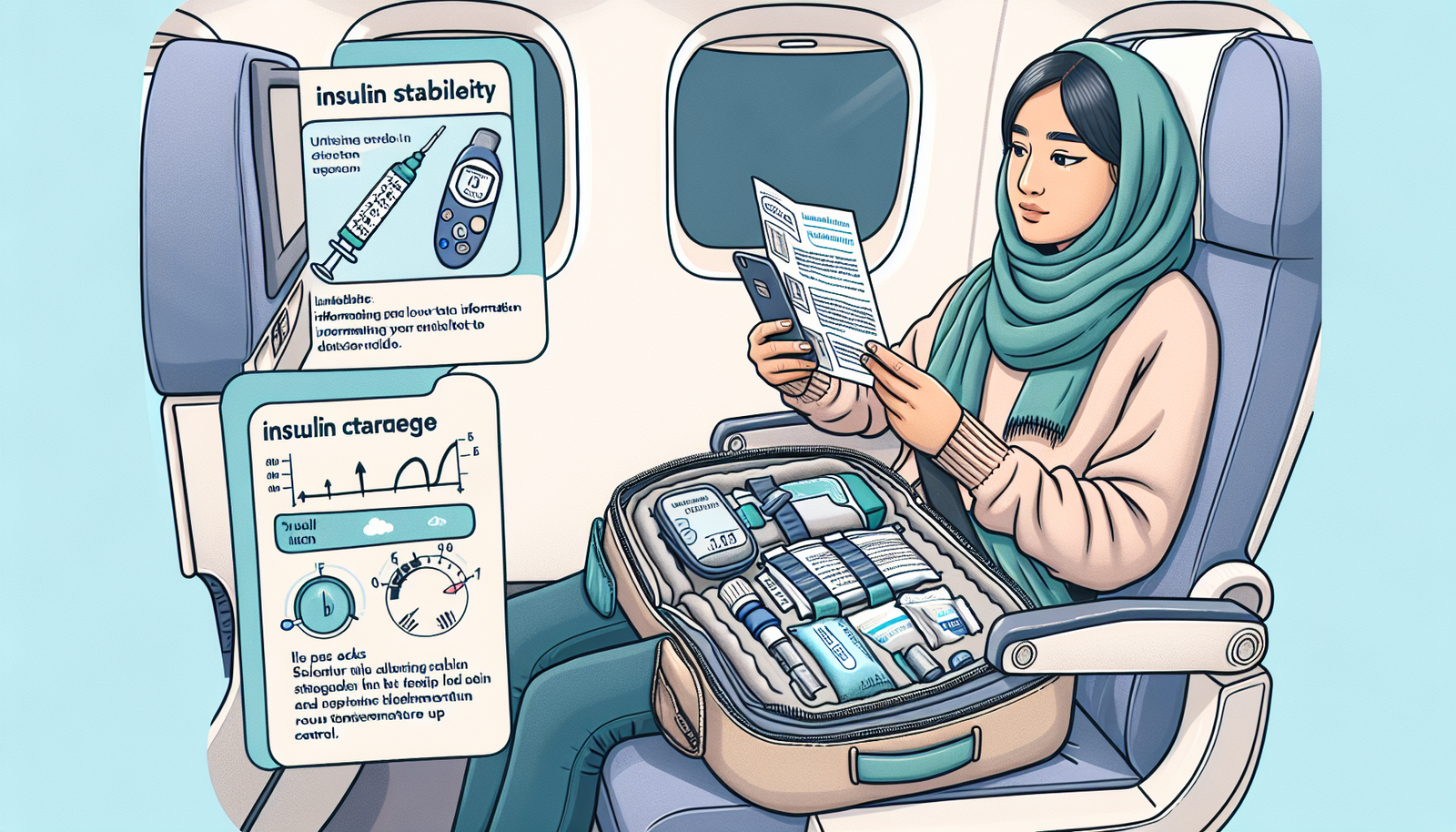When it comes to traveling with insulin, ensuring proper storage and handling is crucial. Whether you’re embarking on a weekend getaway or a long-distance journey, understanding the best practices for transporting and preserving your insulin can make all the difference in maintaining its effectiveness and ensuring your peace of mind. In this article, we will explore some practical tips and advice to help you navigate the challenges of traveling with insulin, so you can focus on enjoying your trip worry-free.

Understanding Insulin’s Sensitivity
Insulin is a hormone produced by the pancreas that plays a crucial role in regulating blood sugar levels in the body. It allows cells to absorb glucose from the bloodstream and use it for energy. However, insulin is a sensitive substance that can be affected by various factors, including extreme temperatures.
Why is Insulin sensitive?
Insulin is sensitive to both heat and cold temperatures. When exposed to extreme heat, such as in a hot car or under direct sunlight, insulin can denature and lose its effectiveness. On the other hand, extreme cold temperatures can cause insulin to freeze, rendering it unusable. This sensitivity makes it important to take proper precautions when traveling with insulin to ensure its potency and effectiveness.
Effects of exposure to extreme temperatures on insulin
Exposure to extreme temperatures can have detrimental effects on insulin. High temperatures can cause insulin to break down, leading to a loss of potency. This can result in uncontrolled blood sugar levels and potentially dangerous health complications. Similarly, freezing temperatures can cause insulin to crystallize, making it difficult to use and potentially ineffective in regulating blood sugar. It is crucial to protect insulin from extreme temperatures to ensure its efficacy.
Preparation Before Travel
Before embarking on your journey, there are several steps you should take to ensure a smooth experience while traveling with insulin.
Check your insulin supply
It is essential to check your insulin supply before traveling to ensure you have enough to last throughout your trip. Calculate the amount of insulin you will need based on your daily dosage and the duration of your travel. It is advisable to carry extra insulin in case of any unexpected delays or emergencies.
Packaging insulin for travel
Proper packaging of insulin is crucial to protect it from temperature fluctuations and physical damage. Use an insulated bag or cooler that can maintain a stable temperature for your insulin. You can also consider using gel packs or ice packs to help regulate temperature during travel.
Traveling with a doctor’s note
Obtaining a doctor’s note stating that you require insulin for medical reasons can be helpful when going through security checks at airports or crossing borders. This note can help explain the presence of syringes, insulin vials, or insulin pens in your luggage and expedite the security screening process.

Insulin Storage at Room Temperature
If you are traveling to a destination where temperature control is not readily available, it is essential to understand how to store insulin at room temperature.
Ideal conditions for storage
Insulin can be stored at room temperature, typically between 59°F and 86°F (15°C and 30°C), for up to 28 days. However, it is important to avoid exposing insulin to direct sunlight, high humidity, or extreme temperature fluctuations as it can affect its potency.
Possible dangers of improper storage
Improper storage of insulin at room temperature can lead to a loss of potency and reduced effectiveness. Extreme temperatures can cause insulin to become less effective in regulating blood sugar levels, potentially leading to hyperglycemia or hypoglycemia.
Duration of insulin potency at room temperature
Insulin stored at room temperature usually retains its potency for up to 28 days. However, it is advisable to check the manufacturer’s instructions for specific insulin types, as some may have different storage requirements. Monitoring the expiration date and discarding any insulin that has expired is essential to maintain its effectiveness.
Insulin Storage in a Refrigerator
Refrigeration can be a suitable method for storing insulin, especially when traveling to warmer climates or if you have a longer trip planned.
Conditions for refrigerated storage
Insulin should be stored in the refrigerator between 36°F and 46°F (2°C and 8°C). It is important to note that freezing temperatures should be avoided, as they can cause insulin to become ineffective.
Dos and don’ts
When storing insulin in a refrigerator, ensure that it is kept away from direct contact with the cooling elements. Placing insulin in a designated compartment or in a temperature-controlled container can help maintain its efficacy. Avoid storing insulin in the freezer compartment as freezing can render it unusable.
Transitioning from refrigerated to room temperature
If you have stored insulin in the refrigerator, it is essential to allow it to reach room temperature before using it. Cold insulin can be uncomfortable to inject and may affect the absorption rate. Simply take the insulin out of the refrigerator and let it sit at room temperature for approximately 30 minutes before use.

Traveling by Car with Insulin
If you prefer to travel by car, there are several considerations to keep in mind to ensure the safety and effectiveness of your insulin.
Protecting insulin from heat and cold
It is important to protect your insulin from both heat and cold temperatures while traveling by car. Avoid leaving your insulin in a hot car or exposing it to direct sunlight. Consider storing it in an insulated bag or cooler with gel packs to regulate temperature during the journey.
Special considerations for long car trips
For longer car trips, it is crucial to have a plan in place to ensure the proper storage of insulin. If traveling during warmer months or in a hot climate, consider using a car’s air-conditioned compartment or investing in a portable cooler that can maintain a stable temperature.
Safe locations for storing insulin in the car
When traveling by car, store your insulin in a cool location, such as the air-conditioned glove compartment or a cooler with temperature control. Avoid placing it in areas that are exposed to direct sunlight or near heat sources, such as the dashboard or seat pockets.
Traveling by Plane with Insulin
Air travel presents its own set of considerations and regulations when it comes to carrying and storing insulin.
Air travel regulations for insulin
It is important to familiarize yourself with the airline’s regulations regarding the transportation of insulin. Most airlines allow passengers to carry insulin and related supplies in their carry-on luggage. However, it is advisable to check with the specific airline beforehand and carry a doctor’s note or prescription for insulin to avoid any potential complications.
Risks associated with insulin storage in checked luggage
It is generally recommended not to store insulin in checked luggage due to potential temperature fluctuations and the risk of loss or damage. Checked luggage is often exposed to extreme temperatures, which can compromise the effectiveness of insulin. It is best to keep insulin in your carry-on bag to ensure its safety and potency.
Tips for going through airport security with insulin
When going through airport security, notify the security personnel that you have insulin and related supplies in your carry-on bag. It is advisable to separate your insulin from other items and place it in a clear, ziplock bag for easy inspection. Follow the security procedures and cooperate with the officials to ensure a smooth and hassle-free experience.

Insulin Storage in Hotel Rooms
Proper insulin storage in hotel rooms is essential to maintain its potency and effectiveness throughout your stay.
Managing temperature control
Upon arrival at your hotel, ensure that the room temperature is within the recommended range for insulin storage. If the room is too warm, consider adjusting the thermostat or using a portable cooler to maintain a cooler temperature.
Using hotel room refrigerators
If your hotel room is equipped with a refrigerator, it can be a convenient option for insulin storage. However, it is important to check the temperature settings and ensure they are within the appropriate range (36°F to 46°F or 2°C to 8°C). Place your insulin in a container or designated compartment to protect it from direct contact with cooling elements.
Backup solutions when a fridge is unavailable
In case your hotel room does not have a refrigerator or if it is not functioning correctly, there are alternative options to store your insulin. You can use an insulated bag or cooler with gel packs to regulate the temperature. Additionally, you may consider speaking to the hotel staff about storing your insulin in a refrigerator at the hotel’s front desk, where it can be kept in a controlled environment.
Using Insulin Coolers and Cases
Insulin coolers and carrying cases can provide an added layer of protection for your insulin during travel.
Benefits of insulin carrying cases
Insulin carrying cases are specifically designed to maintain the proper temperature for insulin storage. They are often equipped with insulation and gel packs to regulate temperature and protect insulin from extreme heat or cold. These cases also provide convenient organization for insulin supplies and help keep them secure during travel.
Selection criteria for insulin coolers
When choosing an insulin cooler or carrying case, consider factors such as size, insulation capabilities, and durability. Look for a cooler that is suitable for your travel needs, including the number of insulin vials or pens you need to carry. Ensure that the cooler can maintain the desired temperature range for the duration of your travel.
Proper use and maintenance
To ensure the effectiveness of your insulin cooler, it is important to follow the manufacturer’s instructions for proper use and maintenance. Properly pack the cooler with insulin and gel packs, and periodically check the temperature to ensure it remains within the recommended range. Regularly clean and inspect the cooler to maintain its integrity and avoid any potential contamination.

Dealing with Time Zones and Insulin Schedule
Traveling across different time zones can disrupt your insulin schedule. It is important to make adjustments to ensure proper insulin timing and avoid potential complications.
Insulin timing when crossing multiple time zones
When crossing multiple time zones, consult with your healthcare provider to determine the necessary adjustments to your insulin schedule. They can provide guidance on when to administer insulin based on the new time zone and any changes in your meal timing.
Adjusting insulin schedule to travel
To adjust your insulin schedule when traveling, consider the new time zone and the timing of your meals. It may be necessary to shift the timing of your insulin injections to coincide with your new schedule. Gradually adjust your dosages and timing to ensure a smooth transition and prevent any sudden changes in blood sugar levels.
Getting medical advice on insulin timing adjustment
It is crucial to consult with your healthcare provider before making any changes to your insulin schedule. They can provide personalized advice based on your specific needs and help you navigate any challenges that may arise during your travel. Follow their instructions and recommendations to ensure proper insulin timing and maintain optimal blood sugar management.
Emergency Situations and Problem-Solving
While traveling, unforeseen circumstances can arise that may require immediate action. It is important to be prepared and have a plan in place to handle emergency situations and unexpected challenges.
What to do if insulin is lost or damaged
In the unfortunate event that your insulin is lost or damaged during travel, it is important to have a backup plan. Carry extra insulin supplies to account for such situations. If necessary, seek medical assistance at a local pharmacy or hospital to obtain replacement insulin or supplies. Additionally, contacting your healthcare provider for further guidance can be helpful in these situations.
Accessing medical help in foreign countries
If you find yourself in need of medical assistance while in a foreign country, it is advisable to seek help from local healthcare professionals or hospitals. Research and note down the contact information of the nearest medical facilities and carry it with you at all times. Understanding the local healthcare system and having appropriate travel insurance can also provide peace of mind in case of any medical emergencies.
Planning for unexpected travel delays or changes
Travel plans can change unexpectedly due to weather conditions, flight cancellations, or other unforeseen circumstances. It is important to be prepared for such situations and have a contingency plan in place. Carry extra insulin supplies, keep important contact numbers readily available, and stay informed about any travel alerts or advisories. Flexibility and adaptability are key when facing unexpected travel delays or changes.
Traveling with insulin requires careful planning and preparation to ensure its safety and maintained effectiveness. By understanding insulin’s sensitivity to temperature, following proper storage guidelines, and being prepared for potential challenges, you can enjoy your travels while effectively managing your diabetes. Remember to consult with your healthcare provider for personalized advice and recommendations tailored to your specific needs. Safe travels!

